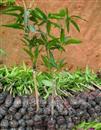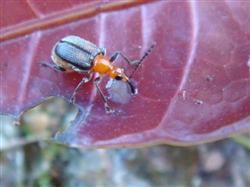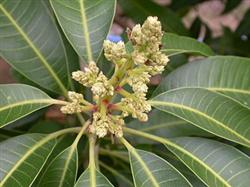How to cultivate mango grafted seedlings

1. Scion selection: the scion is collected from the improved variety mother garden or adult mother tree. The mother plant requires pure variety, high yield, stable yield, high quality and no quarantine diseases and insect pests. All nurseries with suitable conditions should have ear picking nurseries, which are specially used for ear picking and ear grafting. The branches are selected as 1-year-old or 2-year-old branches with sunny, robust, full buds, disease-free and insect-free branches outside the crown, which are generally followed by spring and summer shoots in the same year, spring and summer shoots in last year or spring shoots in the same year. Branches and shady weak branches that are blooming, fruiting or just harvesting fruit are not suitable to be used as scions. The leaves can be removed 10-15 days in advance, and the scion picked after petiole falling off can be soaked in 1000-fold carbendazim for 3 minutes and then picked up after drying, which can improve the survival rate. The harvested scion should be grafted in time, and if it is more than 3 days, it must be stored at low temperature and moisture. If picking ears from other places, tie up the scions, wrap them in wet paper or cloth, and put them in a carton covered with plastic film. Pay attention to protection against sunburn, heat or dehydration and shrinkage during transportation. two。 Grafting time: when the rootstock is 1 cm in diameter (15 cm high from the ground), it can be grafted, and the grafting time can be determined according to the climate. When the temperature was lower than 20 degrees Celsius, the survival rate of grafting decreased with the decrease of temperature, and the grafting from March to April was the best, followed by August to October. In case of drought, water should be irrigated 1-2 days before grafting to improve the survival rate of grafting. High temperature and rainy weather is not suitable for grafting. 3. Grafting method: patch bud grafting and splicing method are often used. (1) Patch bud grafting method: ① selected the rootstock more than 0.8cm, sprouted the interface from top to bottom at 30cm from the ground, made two parallel incisions, 0.8cm ~ 1.0cm wide and 3cm 3.5cm long, cut the upper end of the incision into a tongue, then picked the bark to tear the cortex down, and removed most of the cortex to leave a small section. ② selected a full bud in the middle and upper part of the scion, with the bud as the center, carved a square 2.5 cm in length and 0.5 cm in width in four weeks, deep into the xylem, then pushed to the left with the knife edge on the right side of the incision, and then pushed to the right in the left to take out the bud piece. Or cut the bud with xylem 3 cm 5 cm long and 1.2 cm 1.5 cm wide, then cut the edge into 0.5 cm 0.7 cm wide, tear off the xylem and cut it to 2.5 cm 3.0 cm. ③ placed the peeled buds in the middle of the interface, inserted the lower end into the abdominal capsule, and there was a little gap between the upper end and both sides and the rootstock incision. the bud pieces were tied up with a 0.8-1.0 cm wide ultra-thin film. 20-30 days after ④ inoculation, the interface healed, cut off the upper part of the rootstock bud interface, and then unbound when the buds expanded and protruded. (2) cutting method: ① selected the rootstock with a diameter of more than 0.5cm, cut the rootstock obliquely at 30cm off the ground, peeled a straight cut about 2cm long on the high side, and peeled off part of the xylem at the appropriate depth, and then cut off the cortex. ② peeled off the base of the scion (containing 1 bud and 3 buds) which was similar to the thickness of the rootstock, and cut off all the mouths smoothly from top to bottom on the tip side, with the same length as the rootstock. ③ inserted the scion into the cut of the rootstock, made the cortex match, fastened it from the bottom up with ultra-thin, and sealed the scion. 4. Management of grafted seedlings: (1) wiping buds: after top-cutting grafting, the adventitious buds in the lower part of the grafting interface of rootstocks often germinate, which must be checked once a week and removed in time, so as not to affect the growth of grafted buds. Only one bud was left in the scion, and the rest were erased. (2) Supplementary grafting: after 3 weeks of grafting, the survival of the scion should be checked. If you don't have a job, you should pick it up in time. (3) Fertilizer and water management: that is, the nursery should always be kept moist, not dry or waterlogged. In times of drought, water should be irrigated in time. After one month of grafting, thin fertilizer and water can be applied, urea water should be applied every other month, thin fertilizer should be applied frequently, and the fertilization concentration should be increased month by month. (4) Prevention and control of diseases and insect pests: in the seedling stage, diseases and insect pests are easy to occur, especially Spodoptera litura and anthracnose, we should pay attention to prevention and control. (5) plastic surgery: that is, the main branch that germinates after grafting, and after maturity, the top is removed at a length of about 20 cm to promote the development of lateral branches. When the lateral branches germinate up to 15-20 cm, take off the top and promote the secondary lateral branches in turn. 5. Seedling raising period and method: bag seedlings can come out of the nursery all the year round, but orchards with inconvenient irrigation are not suitable for planting in winter (from November to February of the following year). The new shoots must be old when they come out of the nursery, and cut off if they are not old and must come out of the nursery. At the same time, cut short or remove too many long branches and leaves. Ten days before coming out of the nursery, dig up the whole bag of seedlings, cut off the roots outside the bag, discharge them in situ, and shade, pay attention to keep the seedling bag intact and the soil mass not loose. 6. Seedling selection: grafted seedlings were selected for productive planting. The basic requirements for purchasing or self-propagating grafted seedlings are as follows: the purity of ① varieties is greater than or equal to 97%. The grafting site of ② is not more than 30cm from the ground, the diameter of the rootstock is more than 0.8cm, the scion has more than 2 canopies, each shoot has more than 3 mature leaves, the tip length of the scion is greater than or equal to 15cm, and the diameter at 5cm away from the joint is greater than or equal to 0.5cm. The ③ interface healed well and there was no tumor or ligature. ④ has good growth potential, sound, complete leaves, full of luster, no leaf blight and other quarantine diseases and insect pests and wilting phenomena. The stems and branches are not broken or cracked. The diameter of the soil column of ⑤ bag seedlings is greater than or equal to 11 cm, the height is greater than or equal to 21 cm, and the root system is intact; if the big root is broken due to movement, the new root needs to grow and the leaves return to normal before coming out of the nursery. When ⑥ comes out of the nursery, the bag seedlings should stop watering, and the soil columns should be hardened without rotten bags when leaving the nursery. Before raising seedlings, plant quarantine certificates shall be issued in accordance with the provisions of the National Plant Quarantine regulations, and seedlings with quarantine objects are strictly prohibited from being transferred into the protected areas. Bagged seedlings should keep the plastic bags and soil columns intact and cut off the young shoots that are in the growing period. If the scion has more than three canopy tips, the tender part of the upper part can be cut off and the old shoot can be kept at 2-3 canopies. Pay attention to keep the seedling bag intact in the process of transportation, the soil mass is not loose, guard against heavy pressure, sun and rain during transportation, and should be transported by caravan; after arriving at the destination, unload the seedlings, place them under the shade or shade, and plant (or fake) as soon as possible. Click to get more mango planting techniques click to get more fruit planting techniques
- Prev

How to control the weevil disease of mango
1. Mango leaf-cut weevil is widely distributed, adults feed on mango tender leaves, causing the leaves to dry up, or females lay eggs on the tender leaves and bite off the tender leaves from the base, affecting plant growth. Control methods: during the growth of tender shoots, ① picked up the fallen leaves of the injured plants every 3 days, dried them in the sun and burned them, killing larvae.
- Next

How to apply mango blossom early fertilizer
After the mango ear was damaged by diseases and insect pests, the flower ear was deformed, the flower quality decreased, the flower bud fell off, the flower withered, and could not blossom and bear fruit. The prevention and control methods of diseases and insect pests that harm the flower ear of mango are as follows: first, anthrax is the most serious disease that harms the flower ear, which occurs as soon as the flower ear is pulled out.
Related
- Moge, come on! The staff of the peasant association in the producing area of cantaloupe were frightened when the crowd gathered.
- Causes and Solutions of low Fruit setting rate of Apple
- Symptoms and control measures of passion fruit virus disease
- Fruit growing lesson: how do apple orchards keep high yields?
- Can you build orchards in the mountains? What are the pros and cons?
- How to manage the coloring period of Crisson grape?
- This paper introduces the processing technology of two kinds of fig products.
- How much is a month for retired teachers in rural areas by 2020?
- How can strawberry planting increase sugar content? We should pay attention to management in many aspects.
- What are the cultivation techniques on how to improve the yield of golden fruit?

